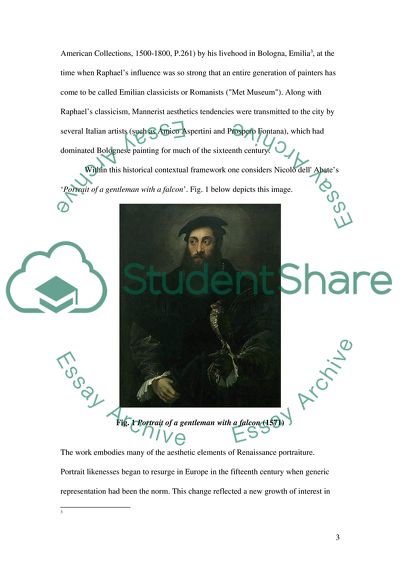Cite this document
(Nicol dell' Abate & Renaissance Masculine Expression Essay, n.d.)
Nicol dell' Abate & Renaissance Masculine Expression Essay. https://studentshare.org/visual-arts-film-studies/1767919-niccolo-dellabate-portrait-of-a-gentleman-with-a-falcon-c1548-50-consider-how-this-portrait-embodies-masculine-power-in-sixteenth-century-italy-take-into-account-the-status-of-the-sitters-and-the-pictorial-means-by-which-position-is-established-e
Nicol dell' Abate & Renaissance Masculine Expression Essay. https://studentshare.org/visual-arts-film-studies/1767919-niccolo-dellabate-portrait-of-a-gentleman-with-a-falcon-c1548-50-consider-how-this-portrait-embodies-masculine-power-in-sixteenth-century-italy-take-into-account-the-status-of-the-sitters-and-the-pictorial-means-by-which-position-is-established-e
(Nicol dell' Abate & Renaissance Masculine Expression Essay)
Nicol dell' Abate & Renaissance Masculine Expression Essay. https://studentshare.org/visual-arts-film-studies/1767919-niccolo-dellabate-portrait-of-a-gentleman-with-a-falcon-c1548-50-consider-how-this-portrait-embodies-masculine-power-in-sixteenth-century-italy-take-into-account-the-status-of-the-sitters-and-the-pictorial-means-by-which-position-is-established-e.
Nicol dell' Abate & Renaissance Masculine Expression Essay. https://studentshare.org/visual-arts-film-studies/1767919-niccolo-dellabate-portrait-of-a-gentleman-with-a-falcon-c1548-50-consider-how-this-portrait-embodies-masculine-power-in-sixteenth-century-italy-take-into-account-the-status-of-the-sitters-and-the-pictorial-means-by-which-position-is-established-e.
“Nicol dell' Abate & Renaissance Masculine Expression Essay”. https://studentshare.org/visual-arts-film-studies/1767919-niccolo-dellabate-portrait-of-a-gentleman-with-a-falcon-c1548-50-consider-how-this-portrait-embodies-masculine-power-in-sixteenth-century-italy-take-into-account-the-status-of-the-sitters-and-the-pictorial-means-by-which-position-is-established-e.


